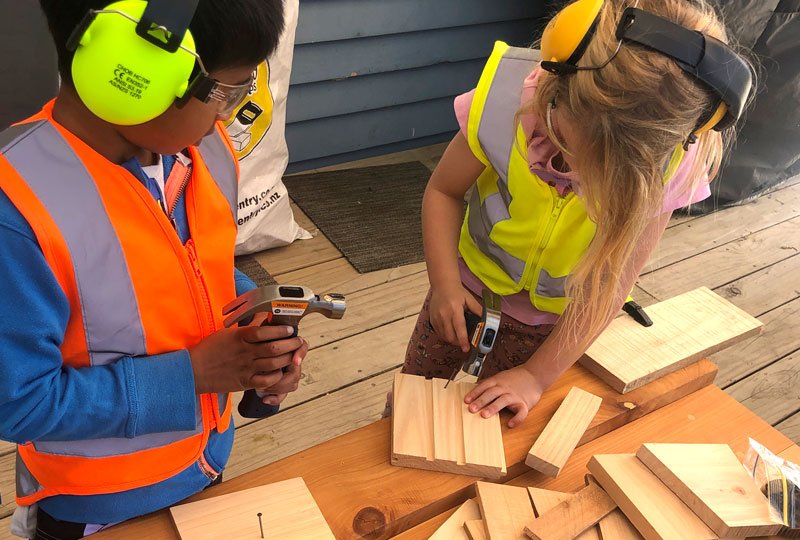Carpentry Safety with Kids:
Guidelines for a Fun and Safe Woodworking Experience
There is no doubt that the benefits of carpentry in early childhood far outweigh the risks. In fact, woodwork is actually quite a low risk activity when introduced and supervised correctly!
Of course, there may be minor injuries such as banged fingers, splinters or small cuts from time to time. But, it’s all part of the learning process!
Children can be taught to respect the carpentry area and be taught to use tools carefully and appropriately. Children actually feel a real sense of pride and responsibility when trusted to use real tools and their behaviour generally reflects this as they rise to the challenge.
Here are some helpful guidelines to follow so you can create a safe and fun woodworking experience with your kids while they learn new skills.
Choose the right tools for kids
One of the most important aspects to consider when introducing children to carpentry is choosing the right tools. It’s essential to select tools that are an appropriate size and weight for children to manage comfortably. Struggling with adult-sized tools that are too big or too heavy isn’t much fun for anyone!
Small-scale woodworking tools designed for children are both safer and easier to use. Their lightweight construction and size make them a perfect fit for young hands, reducing the risk of injury. As a result, children gain confidence in their abilities much faster when using tools that are suitable for them.
It’s important to note here that the tools should be REAL, not plastic. Children respect real tools more than pretend ones, and it helps to reinforce the idea that carpentry is a real skill. Using real tools helps children develop a sense of responsibility, pride and respect for both the tools and the activity.
Although pretend plastic tools may seem harmless, they don’t provide children with a complete understanding of safe tool use and the potential risks involved. In some cases, they may even encourage inappropriate use of tools and create a false sense of security where children don’t fully appreciate the consequences of their actions.
And besides, have you ever tried hammering a nail into wood with a plastic hammer?
Explore the carpentry tools together
It’s a good idea to give children time to explore the tools and get familiar with them before they start woodworking.
Call the tool by its correct name, show them how to hold each tool correctly, and explain the rules of each one.
For example, a saw is only used for sawing wood, and a hammer is only for hammering nails into the craft wood.
Gently feeling the sharp teeth of a saw can help the child understand the potential dangers of the tool and develop a healthy respect for it.
Feeling the weight of a hammer can help the child develop an awareness of the tool’s power and how it can be used to create things.
Watching how a hand drill moves can help the child understand how to properly use the tool and avoid potential hazards.
By first allowing time to simply observe and learn about the tools before actively using them, children can begin to develop the knowledge necessary to use the tools correctly and effectively. Gently feeling the tools, watching them in action, and developing a healthy respect for their power is an important step to help children stay safe while learning and exploring carpentry.
Emphasise safety rules
To ensure a safe carpentry experience, it’s important to establish and enforce safety rules that will prevent injuries and accidents. It’s a great idea to involve your children in the rule making process. This encourages them to take responsibility for their own safety and wellbeing as well as the wellbeing of others.
Here are some examples of safety rules that should be followed in the carpentry area:
Wear proper safety gear:
It’s important to make sure that everyone in the carpentry area is wearing appropriate safety gear. This includes closed shoes, safety glasses, and earmuffs when necessary.Carry tools safely:
Tools should always be carried in a safe and secure manner. Running with tools is never allowed, as it can lead to injury should the child fall over or bump into someone or something. To avoid accidents, tools should be kept close to the work bench and never swung around.No lifting tools above the head:
This rule is important to prevent tools from accidentally falling and injuring themselves or others, especially when hammering. When teaching children how to hammer, it’s best to encourage them to use small, controlled taps rather than huge swinging movements.Use a vice when sawing:
One of my most important safety tips is to use a vice or clamp when sawing wood. This ensures that the wood is held securely in place, preventing it from slipping around and making the cutting process much easier and safer. It’s important to remember that children don’t have the strength to both hold the wood secure and to saw at the same time - which is why using a vice is especially useful. By using a vice or clamp, children can focus on achieving a smooth and successful cut without worrying about struggling to hold the wood steady. Additionally, the use of a vice or clamp helps keep their free hand a safe distance from the saw blade.(For more tips on teaching kids how to use a handsaw safely see our blog post: kidscarpentry.co.nz/handsaw-safety)
Vices and clamps are also very handy for holding wood steady while drilling, rasping and hammering. I consider them to be one of the best safety tools at the carpentry bench.
Tools belong in the carpentry area:
It's important to stress that tools should never be removed from the carpentry area, as they can be dangerous if used outside of that space. Remind children that each tool has a home where it belongs, and encourage them to always put tools back in that specific place when they’re done using them. To prevent tools from getting lost, it’s helpful to set up hooks with outlines of each tool on the wall or inside the door of your carpentry cupboard. This will help children keep track of where each tool belongs and make it easy for adults to notice if something is missing.
Provide adult supervision
Depending on the age and skill level of the children, adult supervision is necessary to ensure their safety. Adults can also provide guidance and support when needed - especially in the beginning when children are just learning.
Parents and teachers should always be present to oversee the carpentry area and be good role models by wearing safety glasses and shoes themselves, and using the tools correctly.
Carpentry can be an incredibly fun and rewarding activity for children when introduced and supervised correctly. If you follow these simple safety guidelines you’ll create a safe and enjoyable carpentry experience for your children.
With the right tools, exploration, and supervision, children can learn new skills, boost their confidence and have fun in the process!



